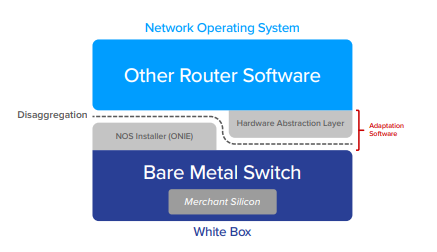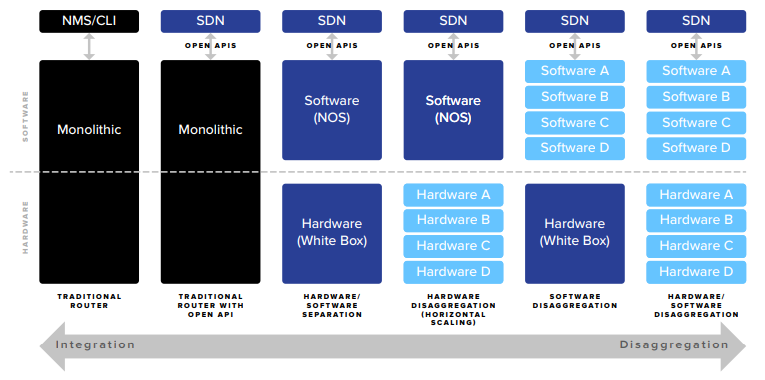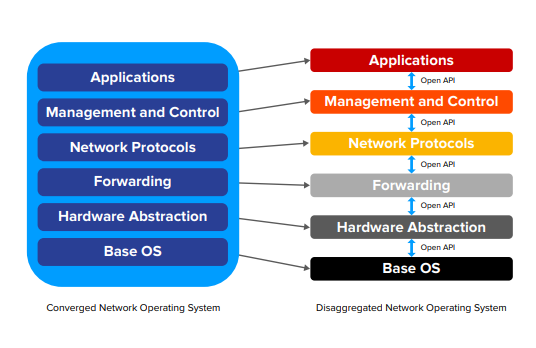What is Disaggregation?
We have heard disaggregation in the server side a lot. Server virtualization is famous from quite a long time. Hypervisor is mainly used to disaggregate from physical server to operating system. Cloud native implementation is enable even operating system disaggregation.
There are so many network evolution and architectural changes are being talked about with the introduction of 5G.
IP routing plays one of the key roles in 5G network. We have not seen so much innovation and changes in IP network from decade. Traditional networking equipment’s are being used in the IP network. Disaggregation is also being observed in IP routing as well. It is quite trending and most importantly, operators are very much interested on this disaggregated IP routing due to so many benefits that we will discuss later.
Disadvantages of traditional router
- Traditional routers are proprietary and it’s kind of close environment. Software and hardware from same vendor.
- Vendor lock-in.
- Slowed innovation due to proprietary equipment’s.
- High cost because of limited vendor.
- Upfront CAPEX is high because you have to purchase full chassis even you have minimum usage requirement. Power consumption is also more.
What is router disaggregation?
Disaggregation is now popular in router as well. Routing disaggregation is nothing but separating routing software and hardware. Hardware is based on merchant silicon called white box and the software is become NOS (network operating system). NOS and white-box may be from different vendor.
Software has to follow certain characteristics to become NOS. We cannot run any software on top of any white-box.


Software need to adapt below two components to become NOS.
ONIE (Open Network Install Environment):
Open Network Install Environment (ONIE) provides an open environment for installing compliant NOS onto third-party white box hardware and is fast becoming a de facto standard.
Hardware Abstraction Layer:
Hardware abstraction layer in the NOS adapts it to run on the specific merchant silicon in the white box.
Disaggregation Journey or Evolution
Disaggregation is not software rather than it’s a journey. Traditional routers are being configured with cli and managed by NMS. Then SDN (Software define networking) comes with open netconf based API’s which provides flexibility on the configuration and management as well. SDN enables some sort of disaggregation of control plan and data plane. Further we see hardware (chassis) disaggregation and software disaggregation as well.

Hardware Disaggregation
Hardware disaggregation means breakout traditional chassis based router to individual white-box unit. Backplane is also replaced with dedicated interconnect cables. Higher scaling can also be achieved by stacking of multiple white-box units.

NOS disaggregation
NOS disaggregation is nothing but building NOS with cloud native approach. Traditional routing software is monolithic and rigid in nature. In disaggregated NOS, application functions can be beak into individual functional block and these functional blocks can be communicate with each other by using open API. This kind of cloud native NOS allow to innovate faster. Operator can also innovate or develop any new feature into the NOS without building complete NOS.

Benefit of disaggregation
Lower Capex and Opex
Disaggregated routing enable openness and remove vendor lock-in. More vendors introduced due to open ecosystem. More vendors mean more choice for operator and competitive pricing due to more choice. Faster innovation is also possible due to open architecture. All of these will reduce CapEx and OpEx.
Reduced Vendor Lock-In
Operators are bound to buy the big chassis and a bundle of hardware and software from single vendor. Operator is basically locked with this vendor for certain time until equipment end of life. We have seen a small number of vendors were dominating the market. But disaggregation enables tremendous opportunity for new vendors to come into routing market. As a result vendor competition increases; operators have more option to buy hardware from one vendor and software from other vendor. This is eventually reduced vendor lock-in and also enables faster innovation.
More Choice
There was no option for operator other than buying proprietary software and hardware from single vendor because there were not so many options for operators. A few numbers of vendors were dominating the routing market. Disaggregation enabled more vendors to come into this market and more choice for the operator. Operators can even buy software from vendor A and hardware from vendor B with competitive price.
Faster Innovation
Disaggregation enables faster innovation due vast open ecosystem. Innovation is the key component for enabling lower CapEx and OpEx, launching new services faster, scale up performance, and better automation etc. These are not possible with traditional monolithic router. Traditional routers are proprietary and constraint by capabilities from single vendor.
Disaggregated router technology provide operator full utilizing of innovation capabilities of the entire ecosystem. It also enable path for entering new small vendor with their innovation into the routing market.
Cost-effective and Flexible Scaling
Disaggregated routing provides option to the operator to select vendor with competitive price. It also provides range of product selection as per usage. Operator needs not to invest upfront payment unnecessary hardware and software licenses those are not required. Operator can buy small capacity white-box and later scale capacity as traffic increases by adding multiple white-boxes stacking.